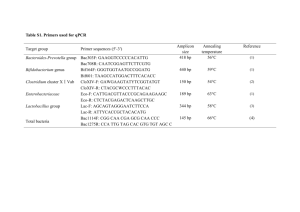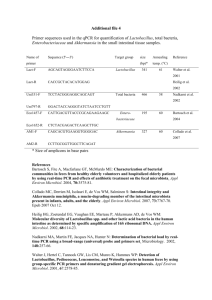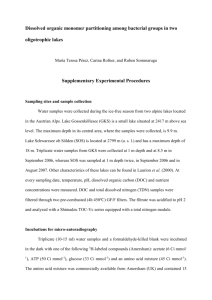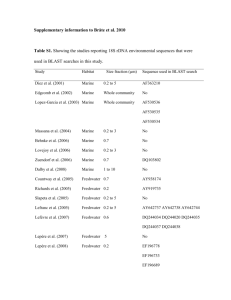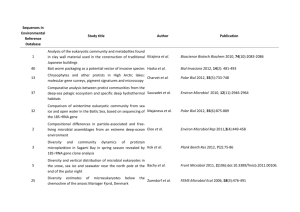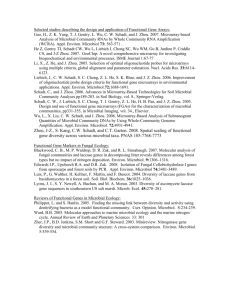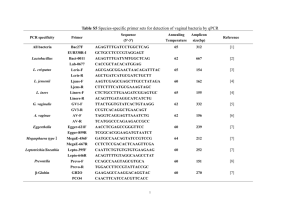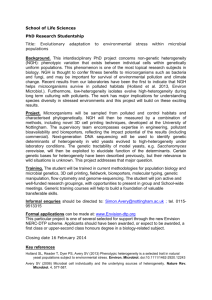Document 12697735
advertisement
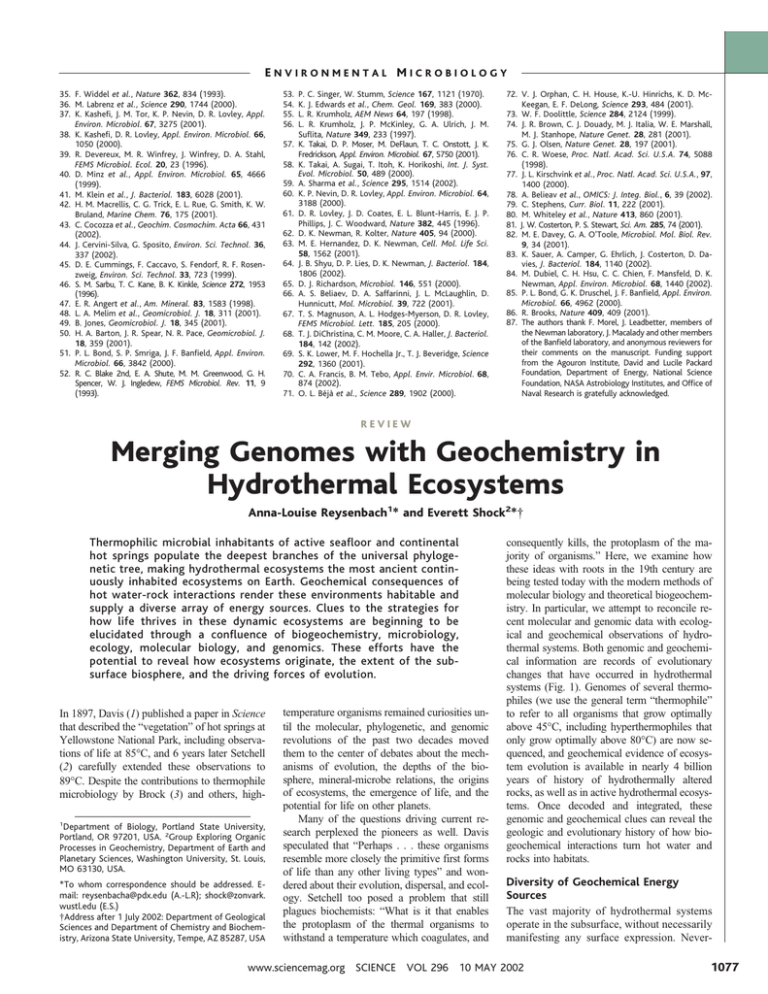
ENVIRONMENTAL MICROBIOLOGY 35. F. Widdel et al., Nature 362, 834 (1993). 36. M. Labrenz et al., Science 290, 1744 (2000). 37. K. Kashefi, J. M. Tor, K. P. Nevin, D. R. Lovley, Appl. Environ. Microbiol. 67, 3275 (2001). 38. K. Kashefi, D. R. Lovley, Appl. Environ. Microbiol. 66, 1050 (2000). 39. R. Devereux, M. R. Winfrey, J. Winfrey, D. A. Stahl, FEMS Microbiol. Ecol. 20, 23 (1996). 40. D. Minz et al., Appl. Environ. Microbiol. 65, 4666 (1999). 41. M. Klein et al., J. Bacteriol. 183, 6028 (2001). 42. H. M. Macrellis, C. G. Trick, E. L. Rue, G. Smith, K. W. Bruland, Marine Chem. 76, 175 (2001). 43. C. Cocozza et al., Geochim. Cosmochim. Acta 66, 431 (2002). 44. J. Cervini-Silva, G. Sposito, Environ. Sci. Technol. 36, 337 (2002). 45. D. E. Cummings, F. Caccavo, S. Fendorf, R. F. Rosenzweig, Environ. Sci. Technol. 33, 723 (1999). 46. S. M. Sarbu, T. C. Kane, B. K. Kinkle, Science 272, 1953 (1996). 47. E. R. Angert et al., Am. Mineral. 83, 1583 (1998). 48. L. A. Melim et al., Geomicrobiol. J. 18, 311 (2001). 49. B. Jones, Geomicrobiol. J. 18, 345 (2001). 50. H. A. Barton, J. R. Spear, N. R. Pace, Geomicrobiol. J. 18, 359 (2001). 51. P. L. Bond, S. P. Smriga, J. F. Banfield, Appl. Environ. Microbiol. 66, 3842 (2000). 52. R. C. Blake 2nd, E. A. Shute, M. M. Greenwood, G. H. Spencer, W. J. Ingledew, FEMS Microbiol. Rev. 11, 9 (1993). 53. 54. 55. 56. 57. 58. 59. 60. 61. 62. 63. 64. 65. 66. 67. 68. 69. 70. 71. P. C. Singer, W. Stumm, Science 167, 1121 (1970). K. J. Edwards et al., Chem. Geol. 169, 383 (2000). L. R. Krumholz, AEM News 64, 197 (1998). L. R. Krumholz, J. P. McKinley, G. A. Ulrich, J. M. Suflita, Nature 349, 233 (1997). K. Takai, D. P. Moser, M. DeFlaun, T. C. Onstott, J. K. Fredrickson, Appl. Environ. Microbiol. 67, 5750 (2001). K. Takai, A. Sugai, T. Itoh, K. Horikoshi, Int. J. Syst. Evol. Microbiol. 50, 489 (2000). A. Sharma et al., Science 295, 1514 (2002). K. P. Nevin, D. R. Lovley, Appl. Environ. Microbiol. 64, 3188 (2000). D. R. Lovley, J. D. Coates, E. L. Blunt-Harris, E. J. P. Phillips, J. C. Woodward, Nature 382, 445 (1996). D. K. Newman, R. Kolter, Nature 405, 94 (2000). M. E. Hernandez, D. K. Newman, Cell. Mol. Life Sci. 58, 1562 (2001). J. B. Shyu, D. P. Lies, D. K. Newman, J. Bacteriol. 184, 1806 (2002). D. J. Richardson, Microbiol. 146, 551 (2000). A. S. Beliaev, D. A. Saffarinni, J. L. McLaughlin, D. Hunnicutt, Mol. Microbiol. 39, 722 (2001). T. S. Magnuson, A. L. Hodges-Myerson, D. R. Lovley, FEMS Microbiol. Lett. 185, 205 (2000). T. J. DiChristina, C. M. Moore, C. A. Haller, J. Bacteriol. 184, 142 (2002). S. K. Lower, M. F. Hochella Jr., T. J. Beveridge, Science 292, 1360 (2001). C. A. Francis, B. M. Tebo, Appl. Envir. Microbiol. 68, 874 (2002). O. L. Béjà et al., Science 289, 1902 (2000). 72. V. J. Orphan, C. H. House, K.-U. Hinrichs, K. D. McKeegan, E. F. DeLong, Science 293, 484 (2001). 73. W. F. Doolittle, Science 284, 2124 (1999). 74. J. R. Brown, C. J. Douady, M. J. Italia, W. E. Marshall, M. J. Stanhope, Nature Genet. 28, 281 (2001). 75. G. J. Olsen, Nature Genet. 28, 197 (2001). 76. C. R. Woese, Proc. Natl. Acad. Sci. U.S.A. 74, 5088 (1998). 77. J. L. Kirschvink et al., Proc. Natl. Acad. Sci. U.S.A., 97, 1400 (2000). 78. A. Belieav et al., OMICS: J. Integ. Biol., 6, 39 (2002). 79. C. Stephens, Curr. Biol. 11, 222 (2001). 80. M. Whiteley et al., Nature 413, 860 (2001). 81. J. W. Costerton, P. S. Stewart, Sci. Am. 285, 74 (2001). 82. M. E. Davey, G. A. O’Toole, Microbiol. Mol. Biol. Rev. 9, 34 (2001). 83. K. Sauer, A. Camper, G. Ehrlich, J. Costerton, D. Davies, J. Bacteriol. 184, 1140 (2002). 84. M. Dubiel, C. H. Hsu, C. C. Chien, F. Mansfeld, D. K. Newman, Appl. Environ. Microbiol. 68, 1440 (2002). 85. P. L. Bond, G. K. Druschel, J. F. Banfield, Appl. Environ. Microbiol. 66, 4962 (2000). 86. R. Brooks, Nature 409, 409 (2001). 87. The authors thank F. Morel, J. Leadbetter, members of the Newman laboratory, J. Macalady and other members of the Banfield laboratory, and anonymous reviewers for their comments on the manuscript. Funding support from the Agouron Institute, David and Lucile Packard Foundation, Department of Energy, National Science Foundation, NASA Astrobiology Institutes, and Office of Naval Research is gratefully acknowledged. REVIEW Merging Genomes with Geochemistry in Hydrothermal Ecosystems Anna-Louise Reysenbach1* and Everett Shock2*† Thermophilic microbial inhabitants of active seafloor and continental hot springs populate the deepest branches of the universal phylogenetic tree, making hydrothermal ecosystems the most ancient continuously inhabited ecosystems on Earth. Geochemical consequences of hot water-rock interactions render these environments habitable and supply a diverse array of energy sources. Clues to the strategies for how life thrives in these dynamic ecosystems are beginning to be elucidated through a confluence of biogeochemistry, microbiology, ecology, molecular biology, and genomics. These efforts have the potential to reveal how ecosystems originate, the extent of the subsurface biosphere, and the driving forces of evolution. In 1897, Davis (1) published a paper in Science that described the “vegetation” of hot springs at Yellowstone National Park, including observations of life at 85°C, and 6 years later Setchell (2) carefully extended these observations to 89°C. Despite the contributions to thermophile microbiology by Brock (3) and others, high1 Department of Biology, Portland State University, Portland, OR 97201, USA. 2Group Exploring Organic Processes in Geochemistry, Department of Earth and Planetary Sciences, Washington University, St. Louis, MO 63130, USA. *To whom correspondence should be addressed. Email: reysenbacha@pdx.edu (A.-L.R); shock@zonvark. wustl.edu (E.S.) †Address after 1 July 2002: Department of Geological Sciences and Department of Chemistry and Biochemistry, Arizona State University, Tempe, AZ 85287, USA temperature organisms remained curiosities until the molecular, phylogenetic, and genomic revolutions of the past two decades moved them to the center of debates about the mechanisms of evolution, the depths of the biosphere, mineral-microbe relations, the origins of ecosystems, the emergence of life, and the potential for life on other planets. Many of the questions driving current research perplexed the pioneers as well. Davis speculated that “Perhaps . . . these organisms resemble more closely the primitive first forms of life than any other living types” and wondered about their evolution, dispersal, and ecology. Setchell too posed a problem that still plagues biochemists: “What is it that enables the protoplasm of the thermal organisms to withstand a temperature which coagulates, and consequently kills, the protoplasm of the majority of organisms.” Here, we examine how these ideas with roots in the 19th century are being tested today with the modern methods of molecular biology and theoretical biogeochemistry. In particular, we attempt to reconcile recent molecular and genomic data with ecological and geochemical observations of hydrothermal systems. Both genomic and geochemical information are records of evolutionary changes that have occurred in hydrothermal systems (Fig. 1). Genomes of several thermophiles (we use the general term “thermophile” to refer to all organisms that grow optimally above 45°C, including hyperthermophiles that only grow optimally above 80°C) are now sequenced, and geochemical evidence of ecosystem evolution is available in nearly 4 billion years of history of hydrothermally altered rocks, as well as in active hydrothermal ecosystems. Once decoded and integrated, these genomic and geochemical clues can reveal the geologic and evolutionary history of how biogeochemical interactions turn hot water and rocks into habitats. Diversity of Geochemical Energy Sources The vast majority of hydrothermal systems operate in the subsurface, without necessarily manifesting any surface expression. Never- www.sciencemag.org SCIENCE VOL 296 10 MAY 2002 1077 ENVIRONMENTAL MICROBIOLOGY theless, these subsurface systems are fully capable of sustaining life, as shown by direct (4–6) and indirect (7, 8) measures of subsurface activity. Without sunlight, life turns to the myriad of geochemical energy sources provided by oxidation-reduction reactions that are far from thermodynamic equilibrium. Many of these energy sources depend, at least in part, on photosynthetic production of O2 and/or reduced carbon compounds, but several are distinctly independent of surface life. Notable among these are those based on H2, which is a constituent of magmatic gases and is also a product of the geochemical reduction of H2O at high temperatures. Metabolic strategies that use H2 to reduce CO2, sulfur, or O2 fuel chemolithoautotrophic primary production in hydrothermal ecosystems and represent energy conservation strategies that can be independent from sunlight. All of these strategies can be traced deeply into the universal tree of life (Figs. 2 and 3). Methanogenesis [CO2(aq) ⫹ 4 H2(aq) 3 CH4(aq) ⫹ 2 H2O] is confined to the Archaea, but both Archaea and Bacteria gain energy from sulfur reduction [S ⫹ H2(aq) 3 H2S(aq)] and the “knallgas” reaction [1/2 O2(aq) ⫹ H2(aq) 3 H2O]. Each of these reactions is kinetically sluggish even when there is enormous thermodynamic potential for the reactions to proceed. Laboratory studies (9) have shown that S reduction and O2 reduction do not proceed measurably in the absence of life at hot spring temperatures, and CO2 reduction to methane fails to equilibrate rapidly even at 500°C. It is precisely these kinetic barriers to thermodynamically favorable reactions that make them such useful sources of energy for biology. Organisms use enzyme catalysts to lower the activation energy barriers and tap into the free energy released as the reactions are allowed to proceed. In addition to thermodynamic and kinetic constraints, the possibility that these reactions can supply energy also depends on the availability of the reactants. The availability of O2, and therefore metabolism based on the knallgas reaction, are limited to somewhat shallower regions of hydrothermal systems, maybe the upper few hundred meters in continental systems where O2 from the atmosphere can penetrate. In submarine hydrothermal systems, the supply of O2 depends on the mixing ratio of cold O2bearing seawater with the hydrothermal fluids that supply the H2. In the ideal case, it takes Fig 1. Hydrothermal ecosystems are the most ancient continuously inhabited ecosytems on Earth. The geochemistry of hydrothermal systems directed the evolution of life on early Earth (A). In turn, as biological processes such as photosynthesis evolved, biological activity influenced geochemistry (B). This ecosystem evolution is recorded in hydrothermally altered rocks and potentially in the genomes of extant thermophiles (C). Numerous genome sequences of thermophiles are available that provide genetic information pertaining to their geochemical and ecological history and their metabolic potential (D). For example, Archaeoglobus fulgidus contains methanogen-specific genes, probably as a result of lateral gene transfer, which suggests that methanogens and sulfate reducers occupy similar ecological niches. Future directions in research will build links between genomes and geochemistry by exploring gene expression of thermophilic cultures or microbial communities growing under different geochemical and physical conditions (E). Sequences of such geochemically expressed genes could then be compared to the growing database of genome sequences. [Photo insert, courtesy of Karen Von Damm.] 1078 about 2.5 kg of 2°C seawater mixed with 1 kg of 350°C vent fluid to create a 100°C fluid. If no reactions consume or produce O2 as the fluids mix, then the deep seawater concentration of 0.076 mM would be diluted by the O2-free vent fluid to about 0.055 mM. Similarly, barring reactions, the H2 concentration of the mixture would be diluted to about one-third of the concentration in the vent fluid or, for a fluid from 21°N on the East Pacific Rise (10), to 0.48 from 1.7 mM. Nevertheless, these concentrations would still be far from equilibrium with each other, allowing marine members of the Aquificales [such as Aquifex pyrophilus (11)] and the hyperthermophile Pyrolobus fumarii [maximum growth temperature, 113°C (12)] to gain energy from this water-making reaction. In fact, if only dilution has decreased the concentrations of O2(aq) and H2(aq) in a 100°C submarine hydrothermal fluid, there is more than 100 kJ of energy available per mole of electrons transferred in the knallgas reaction. This is sufficient energy to fix CO2 and/or produce adenosine triphosphate and compares favorably with other sources of energy in submarine hydrothermal ecosystems (13). With sufficient geochemical analyses, it is now possible to evaluate the hydrothermal energy supply from hundreds of metabolic reactions (14) and to relate geochemical variability with the diverse metabolic strategies ongoing in a single community, or in some cases within an individual isolate. Emerging Views of Thermophilic Microbial Diversity Over the past two decades, there has been an enormous increase in the number of new thermophilic isolates [reviewed and references in (15)], all of which have devised metabolic strategies to take advantage of the diversity of geochemical energy sources associated with deepsea and continental hydrothermal vents. These include microaerophiles, aerobes, and anaerobes; heterotrophs that use organic carbon as their sole energy and carbon source, sometimes coupling this with, for example, reduction of iron, as does Geoglobus ahangari (16); and chemolithoautotrophs that use inorganic energy sources and fix CO2, such as the archaeum Methanocaldococcus jannaschii (17) and the bacterium Desulfurobacterium thermolithotrophum (18). Meanwhile, with the use of culture-independent approaches based on molecular phylogenies of the small subunit ribosomal RNA gene (16S rRNA gene), our view of microbial diversity at deep-sea and continental hot springs has expanded considerably. Instead of obtaining isolates one at a time, molecular assessments simultaneously reveal a plethora of novel lineages associated with thermal environments (19–21). We now know that the available isolates represent only a tiny percentage of the diversity of life at high temperatures. As an example, two assessments conducted in Obsidian Pool, a hot 10 MAY 2002 VOL 296 SCIENCE www.sciencemag.org ENVIRONMENTAL MICROBIOLOGY spring at Yellowstone National Park, revealed 86 novel lineages, 32 within the Archaea (19) and 54 within the Bacteria (20), many of which represent groups of microorganisms never seen previously at high temperatures. Within the Bacteria alone, 12 novel division-level lineages were proposed. One surprise from the assessment of the Archaea in Obsidian Pool was the presence of sequences that branched deeply within the archaeal kingdom Crenarchaeota or below the bifurcation between the Crenarchaeaota and the Euryarchaeaota. This discovery led to the proposition of a third kingdom within the Archaea, the “Korarchaeota” (19). Subsequently, additional korarchaeotal sequences were obtained from numerous continental and shallow marine hot springs (21–23), and Burgraff et al. (24) were able to maintain members of the “Korarchaeota” in continuous-flow bioreactors as enrichment cultures. In addition to developing strategies to grow this elusive group based on geochemical constraints, it should be feasible to develop large insert [bacterial artificial chromosome (BAC)] clone libraries of environmental DNA where these organisms reside in abundance, such as in the actively venting smectite deposits off the coast of Iceland (23). Sequencing of BAC libraries containing environmental DNA has provided important insights into several abundant and as yet unculturable microorganisms from the environment (25–27). The genetic diversity exhibited by some continental hot springs correlates with the geochemical diversity observed at these sites. The abundance of energy from an individual reaction will vary accordingly, providing a wealth of potential energy sources that can support many different metabolic strategies. At Obsidian Pool, reduced constituents such as hydrogen sulfide, ammonia, and methane are far from equilibrium with their oxidized counterparts such as sulfate, nitrate, and carbon dioxide, as are H2 and O2. Carbon dioxide and H2 are out of equilibrium with methane, making methanogenesis a plausible energy source; whereas in the same samples, methane and O2 are out of equilibrium with CO2, which means that energy is available from methanotrophy as well. The entire carbon cycle may be operating in this hot spring, yet Obsidian Pool is neither unique nor the most extreme example from Yellowstone. Ammonia concentrations in some Yellowstone springs vary from 0.007 to 46.7 millimolal, pH ranges from ⬍2 to ⬎9, and trace elements such as Al, Fe, Mo, W, and Zn exhibit concentrations ranging from two to five orders of relative magnitude. These variations can produce radically different habitats in close proximity and change rapidly over time as well, selecting for organisms that respond rapidly to these geochemical fluctuations. In addition to factors such as the abundance of energy from other sources, pH resilience of enzymes, nutrient availability, competition for resources, and the extent to which colonization has occurred, organisms that are able to use a suite of different electron donors and acceptors would have a competitive advantage in a geochemically dynamic environment. Metabolic plasticity of this type has been demonstrated in many different thermophiles such as Pyrobaculum aerophilum (28) and Persephonella marina (29). It may also account for the distribution of relatives of Hydrogenobaculum acidophilus populating an acid stream in Yellowstone’s Norris Geyser Basin (Fig. 2). These organisms can oxidize hydrogen (with O2 ) along a chemical and temperature gradient, and these same organisms may also oxidize arsenite once sulfide concentrations have decreased (30, 31). In addition to remarkable thermophilic di- versity, culture-independent phylogenetic studies also reveal the widespread occurrence of certain lineages. This is particularly noticeable among samples from actively venting submarine hydrothermal chimneys. For example, an archaeal lineage (DHVEG) endemic to vents is prevalent in clone libraries (Fig. 3) from samples from the western Pacific (Manus Basin, Okinawa Basin sediments, and Myojin Knoll in the Izu-Ogasawara arc); along the East Pacific Rise, Juan de Fuca Ridge, in the Indian Ocean; and from an in situ growth chamber experiment on the Mid-Atlantic Ridge (21, 32) (33–35). Some of these diversity assessments also yielded 16S rRNA sequences most closely related to sequences previously associated with zones of anaerobic methane oxidation in sediments [the ANME-1 group (33, 36, 37)]. It is generally agreed that in most hydro- Fig 2. The 16S ribosomal RNA phylogenetic tree was constructed on the basis of 1301 homologous positions, using maximum likelihood analysis and the ARB analysis package (http://www.mikro. biologie.tu-muenchen.de/pub/ARB/). GenBank accession numbers follow the clone or organism name. Asterisks indicate genomes of thermophiles for which there is a completed sequence. Red indicates organisms that can use the knallgas reaction (many of the marine isolates can also reduce nitrate), blue indicates chemolithoautrophic and heterotrophic sulfur reducers, sky blue indicates methanogens, green indicates sulfate or iron reducers, yellow indicates heterotrophs, and black indicates nonthermophiles or 16S rRNA sequences from the environment. Many thermophiles can use additional electron acceptors and donors than those depicted (15). www.sciencemag.org SCIENCE VOL 296 10 MAY 2002 1079 ENVIRONMENTAL MICROBIOLOGY thermal environments at moderate temperatures (50° to 90°C), the communities are dominated by Bacteria (20, 34) and that Archaea may only dominate in environments at ⬎90°C. At deep-sea vents, the ε-Proteobacteria appear to be prevalent. In particular, one lineage that has been proposed to be endemic to vents (38) also appears to dominate the clone libraries obtained from sulfide deposits from the East Pacific Rise, southern East Pacific Rise, and Indian Ocean (35, 38). These Bacteria are sulfur reducers, and some are obligate chemolithoautotrophs (Nautilia lithotrophica) growing optimally in the lab between 45° and 50°C (39, 40). In continental thermal springs ( pH 6 to 8, 60° to 86°C), one group of Bacteria prevails: the Aquificales or knallgas bacteria (22, 41, 42). This order is represented by two major lineages, one represented by the genera Aquifex and Hydrogenobacter and a second most often associated with enhanced sulfide mineral precipitation at near-neutral pH in thermal springs in Japan (41), Kamchatka (43), Iceland (42), Yellowstone (22), and the Azores (44) (Fig. 2). These molecular phylogenetic assessments are providing guides to enrichment culturing approaches, resulting in novel isolates from thermal environments. For example, a community of pink filaments such as those in Octopus Spring, Yellowstone National Park, was described by Davis and Setchell. These have been used as benchmarks for upper temperature limits for life, yet until recently, it was not possible to grow them, let alone identify them. A molecular phylogenetic assessment of this community revealed that most of the members were Aquificales (45), and Huber et al. (46) sub- sequently grew these in pure laboratory cultures and named them Thermocrinis ruber. As an illustration of the importance of laboratory cultures in ecological studies, Jahnke et al. (47) showed, by comparing compoundspecific stable isotope ratios of biomarker compounds from T. ruber cultures with filamentous samples from Octopus Spring, that these organisms use formate rather than carbon dioxide as their source of carbon in situ. Some deep-sea vent bacteria are closely (32) related to the Aquificales sequences obtained from Calcite Springs, Yellowstone. Recently, the first member of this lineage was isolated [Persephonella marina (29, 48)], and cultures are now available from shallow marine vents in Italy [Hydrogenothermus marinus (49)], from other deep-sea vent environments (50), from subaerial springs in the Azores, and from Yellowstone (44) (Fig. 3). The widespread occurrence of the Aquificales in deep-sea and continental thermal springs may reflect their ability to occupy zones of rapid mixing between hydrothermal fluids and cold oxygenated seawater at deep-sea vents ( providing a suite of different electron acceptors) and those continental hot springs where oxygen availability is limited to zones of shallow flow or turbulent mixing. Ecology of Thermophiles Fig 3. The 16S ribosomal RNA phylogenetic tree was constructed on the basis of 1307 homologous positions using maximum likelihood analysis and the ARB analysis package (http://www.mikro.biologie.tu-muenchen.de/pub/ARB/). GenBank accession numbers follow the clone or organism name. Asterisks indicate genomes of thermophilic Archaea for which there is a completed sequence. Red indicates organisms that can use the knallgas reaction (many of the marine isolates can also reduce nitrate), blue indicates chemolithoautrophic and heterotrophic sulfur reducers, sky blue indicates methanogens, green indicates sulfate or nitrate reducers or iron oxidizers, yellow indicates heterotrophs, and black indicates nonthermophiles or 16S rRNA sequences from the environment. Many thermophiles can use additional electron acceptors and donors than those depicted (15). 1080 In addition to in situ ecological experiments, studying microbial isolates or consortia under laboratory conditions provides further clues to their growth, survival, and ecological strategies in the environment. Additionally, the many thermophilic genomes that have been sequenced over the past 6 years provide a resource for exploring ecological potential and for linking gene expression with environmental parameters. It is becoming clear that microbial communities adapt to dynamic chemical and physical conditions in complex ways, as illustrated in biofilm formation (Fig. 4). For example, Thermococcus is perhaps the most frequently isolated thermophile from deep-sea vents, although molecular phylogenetic assessments do not always detect this group (51). Strains of the Thermococcales have also been isolated from diffuse (cool) flow areas at deep-sea vents and may represent Thermococcales in the sub-seafloor (7), where they may develop biofilms to ensure the formation of robust stable communities that are not entrained in the dynamic fluid flow. Indeed, members from both the Thermococcales and Archaeoglobales are capable of forming copious amounts of capsular polysaccharides and exopolysaccharides in laboratory cultures, often under conditions of stress (52). Furthermore, it has been estimated (53) that during exopolysaccharide formation, phosphosugars are diverted from primary metabolism, with a consequent impact on cellular metabolism. Therefore, understanding the mechanisms of biofilm formation and regulation could reveal 10 MAY 2002 VOL 296 SCIENCE www.sciencemag.org ENVIRONMENTAL MICROBIOLOGY how these isolates function in this environment, especially when coupled with geochemical assessments of energy supply. Not only is it important to microorganisms to remain in place in stable habitats by building biofilms, but motility provides a mechanism by which microorganisms can respond to geochemical or thermal gradients and find new environments. One outcome from the genomic comparison between P. furiosus and P. horikoshi was that although both species are motile, no bacterial-like methylated chemotaxis genes could be detected for P. furiosus (54). Similarly, there was no evidence for the genes for classical chemotactic signal transduction pathways in the Mcd. jannachii and Aquifex aeolicus genomes (55, 56), raising questions about mechanisms of regulation of motility that these thermophiles might exhibit at hydrothermal vents. Thermotaxis may be more important than chemotaxis for thermophiles, because maintaining a position in a thermal gradient is probably critical. Therefore, thermophiles may require a much simpler thermosensor than the complex regulation of chemotaxis proteins (57). Some in situ experiments suggest that successional changes occur once a biofilm is established at deep-sea vents, including colonization by heterotrophs such as the Thermoccoccales (15, 32). Variablity in 16S rRNA sequence data implied that various Thermococcales populations are present in this biofilm, each of which is perhaps capable of using different organic carbon sources, such as proteinaceous compounds. Indeed, from genomic comparisons of the closely related isolates P. furiosus, P. horikoshi, and P. abyssi, there are substantial differences in the proteolytic repertoire of this group (58), implying that in the environment, these closely related organisms could cohabit the same biofilm if a diversity of carbon sources were available. Furthermore, when P. furiosus, P. abyssi, T. profundus, T. peptonphilus, and Thermotoga maritima were grown in the same medium at their respective temperature optima, they produced a very different suite of extracellular proteases (58), which suggests that at deep-sea vents, genetically related but physiologically distinct Thermococcales evolved to occupy slightly different temperature regimes and use slightly different proteinaceous compounds. This is reminiscent of the potential resource partitioning associated with different ecotypes seen in hot-spring cyanobacterial mats (59) or with marine Synchecoccus and Prochlorococcus isolates (60). In order to occupy a specific ecological niche, the genomes have responded to the environmental and geochemical gradients, even on a fine scale. Genomic data are providing additional insight into the ecological potential of some thermophiles. As an example, the genome of A. aeolicus, a very close relative of A. pyrophilus, brought into question the deeply rooted branching of this lineage within the bacterial domain (56). Yet, pertinent to how genomes provide clues to an organism’s ecophysiology, A. aeolicus is unable to grow in the laboratory with nitrate as an electron acceptor, whereas its close relative and most other marine Aquificales can [(11) and reviewed in (15)]. However, a nitrate reductase was identified in the genome of A. aeolicus; therefore, this organism probably can use nitrate, and the laboratory conditions for growth of this organism on nitrate have not been determined. Thermophiles use numerous strategies that enable them to survive fluctuating temperature environments, where exposure to supraoptimal temperatures is probably the norm rather than the exception. As an example, the concentration of an unusual phosphorouscontaining solute, di-myo-inositol-1,1⬘-phosphate (DIP) increases from about 60 mM to over 1.0 M when P. furiosus is grown at supraoptimal temperatures (⬎100°C). Other thermophiles such as Thermotoga maritima, Mcd. jannaschii, and Archaeoglobus fulgidus produce DIP or similar compounds such as cyclic-2,3-bisphosphoglycerate or di-glycerol-phosphate [DGP (61, 62)]. These are all thought to be involved in thermoprotection of some biomolecules and may serve as compatible solutes [as is the case for DGP (63)], assisting the cell in responding to osmotic shock. Other thermal adaptive features that enable thermophiles to thrive include mechanisms for thermal stable design of proteins (64), heat shock adaptations, and efficient DNA repair. Sulfolobus shibatae and Pyrococcus strain ES4 (64, 65) demonstrate a heat shock response (a general term for stress-related adaptation) due to a shift to supraoptimal temperatures. Others, such as T. barophilus, a barophilic thermophile, produce elevated concentrations of a protein related to the ubiquitous heat shock proteins when grown under atmospheric pressure and not at 200 atm—the pressure from which it was originally obtained (66). At high temperatures, DNA stability is reduced and mutational frequencies increase, providing many dilemmas for thermophiles. Many produce proteins that help stabilize DNA, such as reverse gyrases (67) (Thermotoga, Aquifex, and most thermophilic Archaea) and histones (in Euryarchaeota) (68). Furthermore, although the hyperthermophiles P. furiosus and P. horikoshi are closely related to each other based on 16S rRNA sequence analysis, their genomes differ significantly in gene order, with displacements and inversions. The high frequency of inversions and insertions present in these two isolates may result from the high rate of DNA damage and repair that the organisms are con- fronted with in their ecological niches (54). Support for this argument comes from the fact that P. furiosus is extremely resistant to radiation (69). But because no proteins induced by gamma irradiation could be detected (54), the efficient DNA repair mechanism is unknown. Alternatively, it is possible that proteins involved in radioresistance are produced constitutively in thermophiles that are continually exposed to DNA damage in the environment. Additionally, the high fidelity of mutation repair in thermophiles, and particularly in hyperthermophilic Archaea, does provide a competitive advantage in a complex thermophilic community. How hyperthermophilic Archaea do this is still a mystery. The two most common and conserved strategies for repairing DNA are nucleotide excision repair and mismatch repair; both have been detected in Thermotoga and Aquifex genomes, yet neither has been identified in Archaea growing above 80°C (70). It should be kept in mind that a caveat to all of these studies is that they are of single isolates and a limited suite of organisms, far removed from their natural environment. Few attempts have been made to grow thermophiles as consortia as they occur in the environment, although one study showed that growing Thermotoga maritima and Mcd. jannaschii in coculture caused a 10-fold increase in the cell densities of the former (71). However, with the genomes of many model ther- Fig 4. Scanning electron micrographs of microbial biofilms associated with (A) a thermal spring colonized by black filamentous biomass in Furnes, Sao Miguel, Azores ( photo, Jorge Medeiros and Paula Aguiar) and (B) an actively venting deep-sea sulfide deposit from the Edmond vent field along the Central Indian Ridge ( photo, Joost Hoek). www.sciencemag.org SCIENCE VOL 296 10 MAY 2002 1081 ENVIRONMENTAL MICROBIOLOGY mophiles now available, we are poised to query genome arrays of isolates with environmental RNA, in search of expression patterns that may more closely resemble activities in situ. Coupling gene expression studies with analysis of dynamic geochemical variations may soon elucidate some of the driving forces of evolution in hydrothermal ecosystems (Fig. 1). Molecular, physiological, and ecological studies of thermophiles have had ramifications for fundamental processes and questions in biology. For example, whole-genome comparisons that included thermophiles confirmed that lateral gene transfer is prevalent, particularly in organisms that share similar ecological niches (72), and revealed higher resolution of deeper evolutionary relationships among prokaryotic taxa (73). Additionally, aminoacyl–transfer RNA synthesis, once thought to be a conserved process and central to the fidelity of translation of mRNA, was initially shown to have greater biochemical and evolutionary complexity through the analysis of the genome sequence of the hyperthermophile Mcd. jannaschii (74). Thermophily and the Evolution of Life on Earth Environmental conditions are some of the strongest forces that drive evolution. Because hydrothermal systems have prevailed throughout Earth’s history, the extant organisms in these systems and their genomes are living records of changes over geological time. The deeply branching lineages of the universal tree of life are all occupied by thermophiles, although this is still controversial (75, 76). The Aquificales are one of the deepest bacterial lineages, and the metabolic plasticity exhibited by representatives of the group, such as the chemolithoautotrophic Persephonella marina, may thus be a relic of their evolution on a dynamically changing planet. Members of this lineage might have initially evolved using the limited redox couples available in the absence of molecular oxygen. Once photosynthesis drove the shift to an oxic atmosphere, near-surface redox chemistry changed dramatically, and other acceptors such as nitrate would have been available. Whether the ability of many thermophiles to use low concentrations of oxygen was a result of lateral gene transfer, a relic of gaining energy from quenched volcanic gas that can contain minute traces of O2 (77), or an evolutionary response to the changing atmosphere is just as speculative. Understanding how such filamentous organisms thrive in their geochemically dynamic niches, what the mechanisms are by which they become mineralized, and whether they survive fossilization, are all essential in our interpretation of the early rock record (and putative fossils from elsewhere in the solar system). The 1082 urgency of such studies was highlighted recently with the renewed controversy over the nature of some of the earliest fossils (78, 79). Perhaps some of the answers to these riddles are hidden in the genomes and ecology of some of the extant thermophiles. References and Notes 1. B. M. Davis, Science 6, 145 (1897). 2. W. A. Setchell, Science 17, 934 (1903). 3. T. D. Brock, Thermophilic Microorganisms and Life at High Temperatures (Springer-Verlag, New York, 1978). 4. M. R. Fisk, S. J. Giovanonni, I. H. Thorseth, Science 281, 978 (1998) 5. J. R. Marchesi, A. J. Weightman, B. A. Cragg, R. J. Parkes, J. C. Fry, FEMS Microbiol. Ecol. 34, 221 (2001). 6. F. H. Chapelle et al., Nature 415, 312 (2002). 7. M. Summit, J. A. Baross, Proc. Natl. Acad. Sci. U.S.A. 98, 2158 (2001). 8. J. A. Huber, D. A. Butterfield, J. A. Baross, Appl. Environ. Microbiol. 68, 1585 (2002). 9. H. L. Barnes, Hydrothermal Experimental Techniques, G. C. Ulmer, H. L. Barnes, Eds. ( Wiley, New York, 1987). 10. K. L. Von Damm, in Seafloor Hydrothermal Systems: Physical, Biological and Geological Interactions, S. E. Humphris, R.A. Zierenber, L.S. Mullineaux, R.E. Thomson, Eds. (American Geophysical Union, Washington, DC, 1995), pp. 222–247. 11. R. Huber et al., Syst. App. Microbiol. 15, 340 (1992). 12. E. Blöchl et al., Extremophiles 1, 14 (1997). 13. T. M. McCollom, E. L. Shock, Geoch. Cosmochim. Acta 61, 4375 (1997). 14. J. P. Amend, E. L. Shock, FEMS Microbiol. Rev. 25, 175 (2001). 15. A.-L. Reysenbach, D. Götz, D. Yernool, in Biodiversity of Microbial Life, J. Staley, A.-L. Reysenbach, Eds. ( Wiley-Liss, New York, 2002), pp. 345– 421. 16. K. Kashefi et al., Int. J. Syst. Evol. Microbiol., DOI 10.1099/ijs.0.01953-0 (2001). 17. W. J. Jones, J. A. Leigh, F. Mayer, C. R. Woese, R. S. Wolfe, Arch. Microbiol. 136, 254 (1983). 18. S. L’Haridon et al., Int. J. Syst. Evol. Microbiol. 48, 701 (1998). 19. S. M. Barns, C. F. Delwiche, J. D. Palmer, N. R. Pace, Proc. Natl. Acad. Sci. U.S.A. 93, 9188 (1996). 20. P. Hugenholtz, C. Pitulle, K. L. Hershberger, N. R. Pace, J. Bacteriol. 180, 366 (1998). 21. K. Takai, K. Sako, FEMS Microbiol. Ecol. 28, 177 (1999). 22. A. L. Reysenbach, M. Ehringer, K. Hershberger, Extremophiles 4, 61 (2000). 23. V. T. Marteinsson et al., Appl. Environ. Microbiol. 67, 827 (2001). 24. S. Burggraf, P. Heyer, N. Eis, Nature 385, 780 (1997). 25. O. Beja et al., Science 289, 1902 (2000). 26. M. R. Rondon et al., Appl. Environ. Microbiol. 66, 2541 (2000). 27. O. Beja et al., Appl. Environ. Microbiol. 68, 335 (2002). 28. P. Volkl et al., Appl. Environ. Microbiol. 59, 2918 (1993). 29. D. Götz, T. Beveridge, A. Rushdi, B. Simoneit, A.-L. Reysenbach, Int. J. Syst. Evol. Microbiol., DOI 10.1099/ijs.0.02126-0 (2001). 30. H. W. Langner, C. J. Jackson, T. R. McDermott, W. P. Inskeep, Environ. Sci. Tech. 35, 3302 (2001). 31. C. R. Jackson, H. W. Langner, J. Donahoe-Christiansen, W. P. Inskeep, T. R. McDermott, Environ. Microbiol. 3, 532 (2001). 32. A. L. Reysenbach, K. Longnecker, J. Kirshtein, Appl. Environ. Microbiol. 66, 3798 (2000). 33. K. Longnecker, thesis, Oregon State University, Corvallis, OR (2001). 34. K. Takai, T. Komatsu, F. Inagki, K. Horikoshi, Appl. Environ. Microbiol. 67, 3618 (2001). 35. Over 90% of the clones analyzed from a bacterial and archaeal 16S rRNA gene library from an Indian Ocean vent sulfide deposit were related to ε-Proteobacteria and the DHVEG group, respectively ( J. Hoek, F. Hubler, A. Banta, A.-L. Reysenbach, unpublished results). 36. V. J. Orphan et al., Appl. Environ. Microbiol. 67, 1922 (2001). 37. A. Teske et al., Appl. Environ. Microbiol. 68, 1994 (2002). 38. K. Longnecker, A. L. Reysenbach, FEMS Microbiol. Ecol. 35, 287 (2001). 39. B. J. Campbell, C. Jeanthon, J. E. Kostka, G. W. Luther, S. C. Cary, Appl. Environ. Microbiol. 67, 4566 (2001). 40. M. L. Miroshnickenko, et al., Int. J. Syst. Evol. Microbiol., DOI 10.1099/ijs.0.02139-0 (2002). 41. H. Yamamoto et al., Appl. Environ. Microbiol. 64, 1680 (1998). 42. S. Skirnisdottir et al., Appl. Environ. Microbiol. 66, 2835 (2000). 43. C. Takacs, A. Banta, K. Stedman, A.-L Reysenbach, unpublished data. 44. A. L. Reysenbach, D. Götz, A. Banta, C. Jeanthon, I. Fouquet, unpublished data. 45. A. L. Reysenbach, G. S. Wickham, N. R. Pace, Appl. Environ. Microbiol. 60, 2113 (1994). 46. R. Huber et al., Appl. Environ. Microbiol. 64, 3576 (1998). 47. L. L. Jahnke et al., Appl. Environ. Microbiol. 67, 5179 (2001). 48. A.-L. Reysenbach, A. Banta, D. R. Boone, S. C. Cary, G. Luther, Nature 404, 835 (2000). 49. R. Stöhr, A. Waberski, H. Volker, B. J. Tindall, M. Thomm, Int. J. Syst. Evol. Microbiol. 51, 1853 (2001). 50. C. L. Van Dover et al., Science 294 (2001). 51. K. Takai, K. Horikoshi, Genetics 152, 1285 (1999). 52. K. D. Rinker, R. M. Kelly, Biotechnol. Bioeng. 69, 537 (2000). 53. T. R. Jarman, G. W. Pace, Arch. Microbiol. 137, 231 (1984). 54. D. L. Maeder, Genetics 152, 1299 (1999). 55. C. J. Bult et al., Science 273, 1058 (1996). 56. G. Deckert et al., Nature 392, 353 (1998). 57. D. M. Faguy, K. F. Jarrell, Microbiology 145, 279 (1999). 58. D. E. Ward et al., Archaea 1, 63 (2002). 59. D. M. Ward, M. J. Ferris, S. C. Nold, M. M. Bateson, Microbiol. Mol. Biol. Rev. 62, 1353 (1998). 60. G. Rocap, D. L. Distel, J. B. Waterbury, S. W. Chisholm, Appl. Environ. Microbiol. 68, 1180 (2002). 61. L. O. Martins, L. S. Carreto, M. S. Da Costa, H. Santos, J. Bacteriol. 178, 5644 (1996). 62. H. Santos, M. S. da Costa, Methods Enzymol. 334, 302 (2001). 63. M. Roesser, V. Muller, Environ. Microbiol. 3, 743 (2001). 64. J. D. Trent, E. Nimmesgern, J. S. Wall, F. U. Hartl, A. L. Horwich, Nature 354, 490 (1991). 65. J. F. Holden, J. A. Baross, J. Bacteriol. 175, 2839 (1993). 66. V. T. Marteinsson, A. L. Reysenbach, J. L. Birrien, D. Prieur, Extremophiles 3, 277 (1999). 67. P. Forterre, C. Bouthier De La Tour, H. Philippe, M. Duguet, Trends Genet. 16, 152 (2000). 68. K. Sandman, J. N. Reeve, Arch. Microbiol. 173, 165 (2000). 69. J. DiRuggiero, N. Santangelo, Z. Nackerdien, J. Ravel, F. T. Robb, J. Bacteriol. 179, 4643 (1997). 70. D. W. Grogan, Trends Microbiol. 8, 180 (2000). 71. V. Muralidharan, K. D. Rinker, I. S. Hirsh, E. J. Bouwer, R. M. Kelly, Biotechnol. Bioeng. 56, 268 (1997). 72. K. E. Nelson et al., Nature 399, 323 (1999). 73. Y. I. Wolf, I. B. Rogozin, N. V. Grishin, R. L. Tatusov, E. V. Koonin, Biomed. Central Evol. Biol. 1, 8 (2001). 74. D. Tumbula et al., Genetics 152, 1269 (1999). 75. H.-P. Klenk et al., J. Mol. Evol. 48, 528 (1999). 76. H. Philippe, P. Forterre, J. Mol. Evol. 49, 509 (1999). 77. E. L. Shock, J. P. Amend, M. Yu. Zolotov, in The Origin of the Earth and Moon, R. Canup, K. Righter, Ed. (Univ. of Arizona Press, Tucson, AZ, 2000), pp. 527–543. 78. J. W. Schopf, A. B. Kudryavtsev, D. G. Agresti, T. J. Wdowiak, A. D. Czaja, Nature 416, 73 (2002). 79. M. D. Brasier et al., Nature 416, 76 (2002). 80. The authors thank their research groups who have nurtured many of these ideas. A.L.R. is very grateful to Ken Stedman for sharing his broad knowledge of the Archaea, A. Banta for generating the phylogenetic trees, D. Söll and other colleagues for encouraging her to push a different boundary, and her lab for being constructive critics. Supported by NSF and the NASA Astrobiology Institute. Because of the constraints imposed by the extent of this review and limitations in the number of references, we apologize to those whose work we have omitted. This is Group Exploring Organic Processes in Geochemistry contribution no. 241. 10 MAY 2002 VOL 296 SCIENCE www.sciencemag.org
